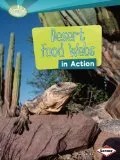After writing about saguaro flowers last week, I came across a lovely new children’s book about them, The Night Flower by Lara Hawthorne.
Lara Hawthorne is an illustrator so it is no surprise this book is an incredible visual treat. The first thing you notice is the stunning cover with a bold white saguaro flower standing out against the black background of night. The image above doesn’t do it justice because because many of the details are outlined with a metallic shiny gold. It has a luminescent 3-D effect. Check out the illustrations at her website.
Inside, the book starts with an informational paragraph about the saguaro cactus. From there gentle rhyming text takes the reader on a journey through one day and night in the desert. Along the way readers meet many different animals and learn about the role the saguaro plays in their lives.
You won’t want to skip the fully-illustrated back matter. Hawthorne describes the life cycle of the saguaro and names the parts of the plant. Next she asks “Did you spot…?” In a two page spread she shows the different creatures mentioned in the text, giving more information about each and challenging the reader to go back through the book to find them. She ends with a glossary of the scientific terms she used.
The Night Flower is a beautiful introduction to a unique plant and its habitat. It is perfect to accompany a unit on deserts or plants, or to prepare for a trip to Arizona. Poke around in a copy today!
Related:
See this previous post for hands-on activity suggestions related to saguaro cacti.
For more information, check out our growing list of children’s books about deserts at Science Books for Kids.
Age Range: 3 – 7 years
Publisher: Big Picture Press (March 12, 2019)
ISBN-10: 1536206164
ISBN-13: 978-1536206166
Disclosure: This book was provided by our local library. Also, I am an affiliate with Amazon so I can provide you with cover images and links to more information about books and products. As you probably are aware, if you click through the highlighted title link and purchase a product, I will receive a very small commission, at no extra cost to you. Any proceeds help defray the costs of hosting and maintaining this website.
Come visit the STEM Friday blog each week to find more great Science, Technology, Engineering and Math books. Note: this is a new link as of 10/2018.









